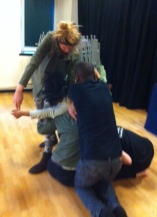In looking forward to our coming Play.Ground Festival at the Albany in February, at a recent rehearsal, StoneCrabs’ 9 young directors talked about how directors use space. In a series of lectures entitled “The Empty Space: The Theatre Today”, the legendary Peter Brook said ‘I can take any empty space and call it a bare stage. A man walks across this empty space whilst someone else is watching him, and this is all that is needed for an act of theatre to be engaged’.
Thus, the empty space has become alive, in a solitary act by the living. But how do we shape this intangibility to our advantage, to help us tell our theatrical stories. Theatre space comes in all shapes and sizes: from the grand stages to intimate black boxes, to the outdoor, or site specific locations such as disused factories, church crypts or dungeons. This space, as defined by a man walking across, leads to the question of how long or how wide it is. Measuring the length of the walk, which when taken quickly or slowly, defines the time to perform the walk – and hence, time and space situate the action (or the ‘play’).
Directors deal with time and space simultaneously in creating a world within a very artificial construct. It is their job to keep every moment alive, and through this series of moments, a fluid line is drawn to take the spectator along the narrative. So, how do we keep this space alive? And what do we mean by ‘alive’?
For instance, in my recent production of ‘Three Sisters’ at Regents University, the staging was rather long and shallow – 8 meters across by 3 meters deep. How does one stretch the length, without losing tension between the characters and the story telling energy? An example is by a character making an entrance right across the space, or sitting reading quietly at one end – but still connected to the main conversation at the other end of the stage. With small, intermittent movements, the audience will subliminally feel the ‘life’ on this side. Then, other characters could move over to the less used section and start their dialogue there, thus pulling the energy over, and consequently, other characters to come across.
Lighting also plays a big part – when a section of the stage is not used much, a low level keeps that part warm (or ‘alive’) and connected. Hence, the long space is always ‘employed’. Lighting could also focus in on a small area, contrasting this area, which buzzes with activity, to the darkened parts that are not used. The audience’s eye is drawn to the highlighted area, and subliminally forgets about the rest of the stage.
What about a small stage? (e.g. 4m x 3m), how does one create a whole world within this small magic circle: if a ‘large’ sense is to be achieved, then actors are to ‘act out’ – radiate out, from the eyeline, their energy and imagination – i.e. giving a sense of forward and upward…to take the audience out from the epicenter of a 4 x 3 m stage.
Once again, lighting also plays a big part in establishing the mood or feeling of a space – soft focus, warm light that gives a warm and intimate feeling, or a cold light to suggest a harsh centre. It also can spread from a focused area, either quickly or slowly – hence taking the audience’s consciousness immediately or steadily to embrace the space.
And if an intimate and personal relationship is to be established, then the placing of the actors is of vital importance – physical and vocal relationship has to suggest intimacy and privacy. Actors could be close to each other, suggesting intimacy, or place themselves right across the space, and yet retain a direct relationship. This is what I term the ‘tension’ within the space. It is what is in between the two beings that matter, enormously so. This ‘space’, whether at close quarters, or a distance, has to be charged -with energy, meaning, and relationship. It is the job of consummate actors to fill the space with their inner energy made manifest – through objectives, wants, action, and ultimately, meaning.
The director defines the space, likened to providing riverbanks, for the actors’ creative current to flow. Whether it be a bubbling stream, or a mighty waterway, a lazy drift or torrential flood, the director’s job is to shape, drive, control the flow via his definition of the acting space. His ‘riverbanks’ provide the space framework and direction of the team’s creative currents.
Kwong Loke
Joint Artistic Director, StoneCrabs Theatre Company


